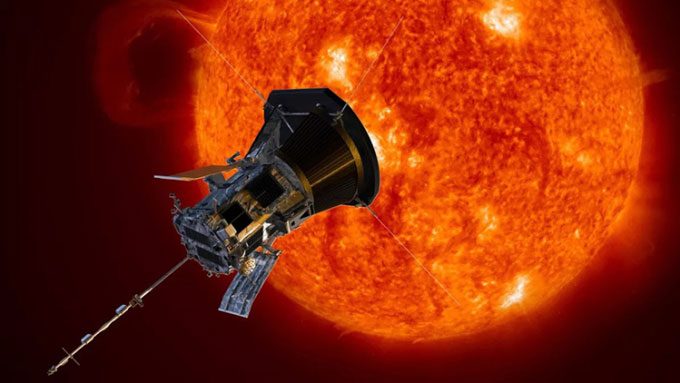After 5 years of operation, the Parker Solar Probe has achieved remarkable accomplishments, including becoming the first spacecraft to “touch the Sun.”
On August 12, 2018, the Parker Solar Probe from NASA launched aboard a Delta IV rocket from Cape Canaveral Space Force Station in the United States. This launch marked the beginning of a groundbreaking mission to explore the mysteries of solar wind, showcasing the pinnacle of decades of technological development—a spacecraft capable of withstanding the heat and radiation near the Sun better than any previous spacecraft.

Simulation of the Parker Probe flying past the Sun. (Image: NASA).
Design concepts for the solar probe began to take shape in 1962, just four years after the Space Science Board of the U.S. National Research Council first proposed a mission to explore the environment close to the Sun. However, at that time, the technology to carry out such a bold mission, especially effective materials for thermal shields, was not yet available.
Advancements in materials during the 1970s enabled NASA to begin considering a close approach to directly sample the corona—the Sun’s upper atmosphere—and solar wind. The scientific definition of the mission was established during a workshop at NASA’s Jet Propulsion Laboratory (JPL) in 1978. However, the means to deploy the mission would take decades to complete.
In 2007, NASA tasked the Johns Hopkins University Applied Physics Laboratory (APL) to explore the idea of a spacecraft capable of approaching the Sun. From there, with a combination of groundbreaking thermal protection technologies and smart design, the Parker Solar Probe gradually took shape and launched into space in 2018.
In 2021, the spacecraft made history by flying through the outer atmosphere of the Sun, becoming the first spacecraft to “touch the Sun.” Subsequently, it reached speeds of approximately 535,000 km/h, making it the fastest spacecraft in history.
To date, after 5 years of flying through the hottest and dustiest regions of the inner solar system, the Parker Solar Probe has not only survived but has also been performing exceptionally well. The spacecraft has returned data amounting to twice what scientists predicted, helping them understand the origins and characteristics of solar wind.
The spacecraft has now completed its 16th scientific orbit out of 24 planned in the primary mission. On August 21, it will make a close flyby of Venus to gain gravitational assistance, a maneuver that will tighten its orbit around the Sun and enable it to study the surface and atmosphere of Venus.
Thanks to this gravitational assist, on September 27, the Parker Solar Probe will travel at speeds exceeding 635,000 km/h, coming within 7.2 million km of the Sun’s surface, breaking its own records for speed and distance from the Sun. The spacecraft will reduce its distance to the Sun to just 6.1 million km at speeds exceeding 692,000 km/h by December 2024.
“We are in a golden age of solar physics exploration. In just 5 years, Parker Solar has changed our understanding of the Sun and its activities that affect life on Earth. As we get closer to the Sun’s surface, we will learn more about the properties of this star while significantly enhancing our knowledge of space weather and the ability to live and work in space,” stated Nour Raouafi, a scientist on the Parker Solar Probe project at APL.


















































